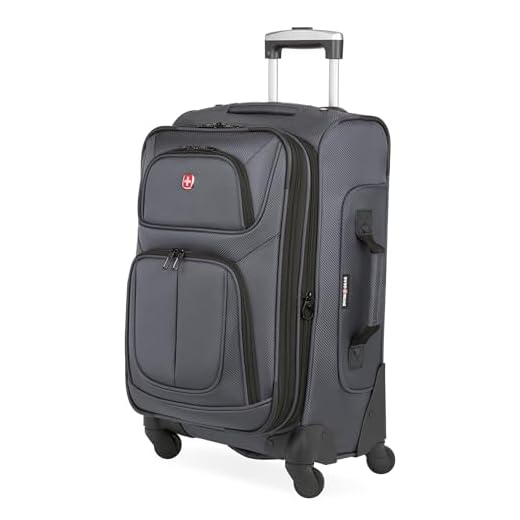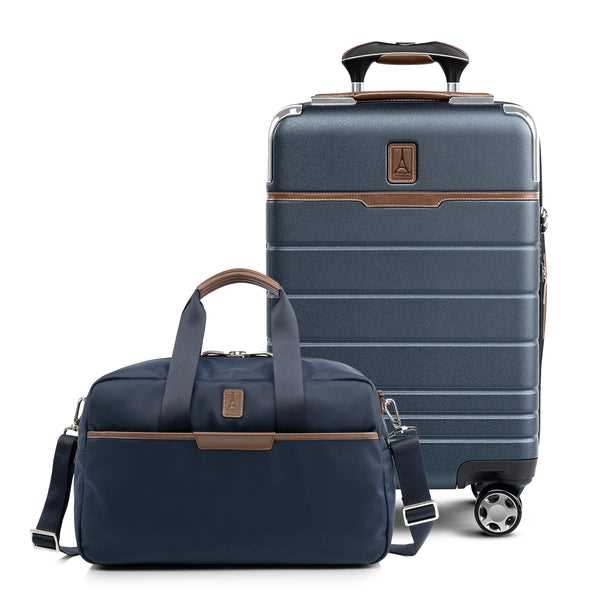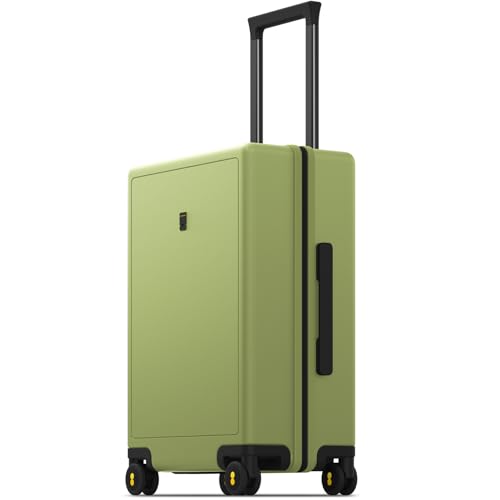








When selecting the ideal carry-on for your next flight, prioritize dimensions and weight. The recommended size is typically around 22 x 14 x 9 inches, which fits most airlines’ restrictions. This article provides guidance on the best options available, taking into account durability, functionality, and style.
Travelers seeking to optimize their packing strategy will find this resource invaluable. It highlights various models suited for short trips and essential features such as wheels, handles, and compartments for easy organization.
Additionally, you’ll discover options that include hard-shell cases for added protection and soft-sided bags that offer flexibility. By the end of this article, you’ll be equipped with the knowledge to make an informed decision, ensuring a smooth travel experience.
Best Options for Air Travel Storage
Choosing the right travel case is key to ensuring a smooth boarding experience. Ideal designs are those that fit snugly within the dimensions set by airlines, making it easier to store above your seat.
Look for cases with lightweight materials that maintain durability. A well-structured bag should offer ample storage without becoming cumbersome. Consider cases that feature a hard shell for protection or soft fabric that allows flexibility when packing.
Features to Consider
- Size: Ensure the dimensions align with airline requirements, typically around 22 x 14 x 9 inches.
- Weight: Opt for lightweight options to maximize packing capacity without exceeding airline weight limits.
- Organization: Multiple compartments and pockets can help keep items accessible and organized.
- Durability: Materials should withstand the rigors of travel, with zippers and handles that can endure frequent use.
- Mobility: Wheels and handles should provide ease of movement through the terminal.
Assessing your specific travel needs can further guide your selection. For example, frequent business travelers may benefit from a design that accommodates laptops and documents efficiently, while casual travelers may prioritize versatility and casual aesthetics.
In addition, consider bags with additional features such as built-in USB ports for charging devices, or those that can expand for extra space when needed. These practicalities can enhance convenience during your travels.
Dimensions That Fit: Understanding Airline Regulations
Airlines typically set specific size limits for carry-on bags, which are crucial for a smooth boarding experience. Most carriers allow pieces measuring approximately 22 x 14 x 9 inches (56 x 36 x 23 cm), including wheels and handles. Understanding these measurements helps travelers select appropriate options that comply with regulations.
Always check the individual airline’s guidelines before packing. Some may enforce stricter dimensions or weight limits, particularly on regional flights. Familiarity with these rules can prevent unexpected fees or the hassle of checking bags at the gate.
Key Points to Consider
- Height, Width, and Depth: Always measure your piece before travel. Include all protrusions like wheels and handles when calculating size.
- Weight Restrictions: Many airlines impose weight limits, often around 15 to 20 pounds (7 to 9 kg). Use a scale to ensure compliance.
- Personal Item: Most carriers allow an additional smaller item, such as a backpack or purse. This item should fit under the seat in front of you.
Compliance with size regulations not only avoids fees but also enhances the boarding process for all passengers. Select options that combine functionality and adherence to these guidelines.
For frequent travelers, investing in a high-quality piece that meets these dimensions can enhance convenience. Many designs maximize interior space without exceeding size limits, allowing for efficient packing.
Recommended Brands for Cabin-Friendly Suitcases
Choosing the right brand can significantly impact your travel experience. Many manufacturers focus on creating compact designs that fit airline restrictions while maintaining durability and style.
Several companies have established themselves as leaders in crafting high-quality travel solutions. Their products often feature innovative designs and materials that cater to the needs of frequent travelers.
Key Features of Leading Brands
- Durability: Look for models made from robust materials that withstand the rigors of travel.
- Lightweight Construction: Opt for options that are easy to carry without compromising on space.
- Smart Organization: Effective internal compartments can optimize packing and accessibility.
- Stylish Designs: Aesthetic appeal adds to the enjoyment of travel, allowing for personal expression.
Consider the warranty and customer service reputation of the manufacturer, as these factors contribute to long-term satisfaction and support. Researching reviews can provide valuable insights into the performance and user experience of various brands.
Ultimately, selecting a reputable brand not only enhances convenience but also adds confidence to your travel plans.
Lightweight Materials: Choosing the Right Fabric
Opt for fabrics that prioritize weight reduction while maintaining durability. Materials such as nylon and polyester are known for their lightweight properties and resistance to wear and tear. These fabrics offer a perfect balance between strength and portability, making them ideal choices for compact travel items.
Another noteworthy option includes ripstop fabric, which features a unique grid pattern that enhances strength without adding unnecessary weight. This can be particularly beneficial for travelers who want to maximize storage without exceeding weight limits imposed by airlines.
Key Features to Consider
- Water Resistance: Select materials that provide a barrier against moisture. This feature protects belongings from unexpected spills or rain.
- Breathability: Fabrics with breathability help prevent odor build-up, keeping contents fresh during longer trips.
- Ease of Cleaning: Choose materials that can withstand frequent cleaning, ensuring they remain in good condition throughout their use.
When evaluating options, consider the weave of the fabric. Tightly woven materials generally offer better strength and durability, while looser weaves may contribute to a lighter overall weight.
In summary, selecting the right fabric involves balancing lightweight characteristics with durability and functionality. By understanding the specific properties of each material, travelers can make informed decisions that enhance their travel experience.
Functional Features: Wheels, Handles, and Compartments
Choosing a travel case that maximizes convenience can significantly enhance the travel experience. When evaluating options, pay close attention to wheels, handles, and compartments, as these elements play a pivotal role in usability.
Wheels should be designed for smooth movement, allowing for easy maneuverability in crowded spaces. Look for cases with multi-directional wheels that provide stability and can glide effortlessly over various surfaces. A robust wheel system can prevent wear and tear, ensuring longevity.
Handles
Comfortable and adjustable handles are another key feature to consider. Telescopic handles should extend smoothly and lock securely, offering multiple height options to accommodate different users. Side and top handles should be padded for comfort, making it easier to lift the case into overhead storage.
Compartments
Multiple compartments help organize belongings effectively. Look for interior dividers or pockets that keep items separated, allowing for quicker access without rummaging. External pockets can be handy for storing travel documents or personal items that need to be readily available.
- Wheels: Multi-directional, durable, and easy to replace.
- Handles: Padded, adjustable, and secure locking mechanisms.
- Compartments: Versatile internal organization and convenient external access.
Incorporating these features will streamline the packing process and enhance the overall travel experience.
Style and Design: Finding the Perfect Look
Selecting the right carry-on can significantly enhance travel experiences. A striking design not only reflects personal taste but also makes a statement during journeys. Consider colors and patterns that resonate with your style while ensuring they remain practical for various settings.
Materials play a crucial role in both aesthetics and functionality. Look for high-quality fabrics or durable plastics that offer a polished appearance while withstanding the rigors of travel. Textures, such as smooth finishes or subtle embossing, can add sophistication to your choice.
Key Elements to Consider
- Color Scheme: Opt for hues that complement your wardrobe. Neutral tones are versatile, while bold colors can be easily spotted.
- Shape and Size: A sleek silhouette that fits snugly in storage areas while maximizing interior space is crucial.
- Functional Features: Look for designs with practical elements like easy-to-grab handles, secure zippers, and organizational pockets.
Ultimately, a well-designed piece should balance style with practicality, ensuring it meets your needs while enhancing your travel aesthetic.
Customer Reviews: Real Experiences with Carry-On Bags
Travelers have shared diverse experiences regarding their choices of compact bags. Many emphasize the significance of size, durability, and organizational features. Reviews highlight that a well-structured carry-on can enhance the travel experience, making it easier to access necessities during flights.
Users frequently recommend models with multiple compartments and expandability options. These features allow for better organization and adaptability to varying packing needs. Here are some insights gathered from real customer feedback:
- Durability: Customers praise brands that offer sturdy materials, noting that they withstand the rigors of travel.
- Size: Many reviews stress the importance of dimensions that fit airline restrictions, preventing last-minute hassle at boarding.
- Weight: Lightweight designs are favored, allowing travelers to pack more without exceeding weight limits.
- Mobility: Smooth-rolling wheels and comfortable handles receive high marks, contributing to ease of transport through airports.
Some travelers have expressed frustration with bags that lack adequate organizational pockets, making it difficult to find items quickly. Moreover, feedback indicates that models with external pockets for quick access to essentials are particularly valued.
In conclusion, selecting the right carry-on can significantly impact travel convenience. Prioritizing features such as durability, size compliance, and organizational capabilities can lead to a more enjoyable experience. Customer testimonials serve as a reliable resource for making informed choices in this essential travel gear.
Best luggage for overhead compartment
Features
| Part Number | LA-8861-07T00 |
| Model | Luminous |
| Color | Pickle Green |
| Size | Carry-On 20 Inch |
Features
| Part Number | 142352-1041 |
| Model | 142352-1041 |
| Color | Black |
| Size | 20 SPINNER |
Features
| Part Number | 6283424161 |
| Model | 6283424161 |
| Warranty | 10 Year Limited |
| Color | Dark Grey |
| Size | Carry-On 21-Inch |
Features
| Part Number | LN20164-20-BL |
| Model | LN20164-20 |
| Color | Black |
| Size | Carry-On |
Video:
FAQ:
What features should I look for in luggage that fits in the overhead compartment?
When selecting luggage for the overhead compartment, consider the dimensions first. Most airlines have specific size restrictions, often around 22 x 14 x 9 inches, so ensure your bag complies with these measurements. Look for lightweight materials to avoid excess weight, as many airlines have strict weight limits. Features like 360-degree spinner wheels can enhance maneuverability through crowded airports. Additionally, compartments for organization, such as pockets for electronics or clothing, can make packing and accessing your items easier. Lastly, a durable exterior fabric can protect your belongings from wear and tear during travel.
Are there specific brands known for their overhead compartment luggage?
Yes, several brands are recognized for producing high-quality luggage designed for overhead compartments. Brands like Samsonite, Travelpro, and Away are popular for their durable construction and thoughtful design features. Samsonite is known for its wide range of stylish and functional options, while Travelpro is favored by frequent travelers for its lightweight and rugged designs. Away has gained popularity for its modern aesthetics and built-in charging capabilities. Researching customer reviews can also help you find the best fit for your needs, as personal experiences often highlight the strengths and weaknesses of different luggage options.







